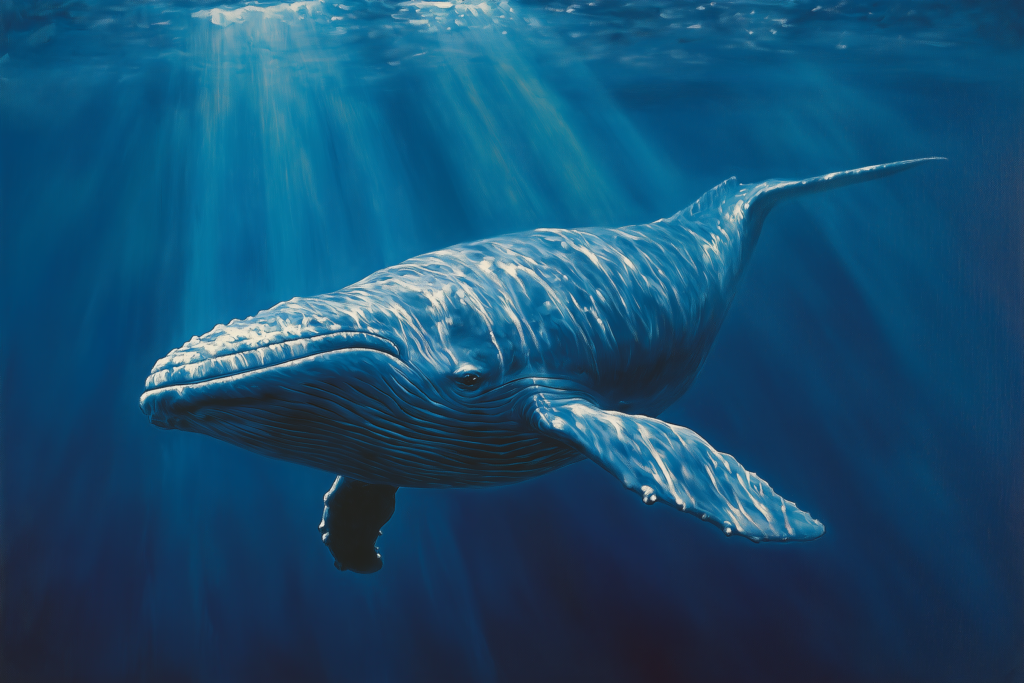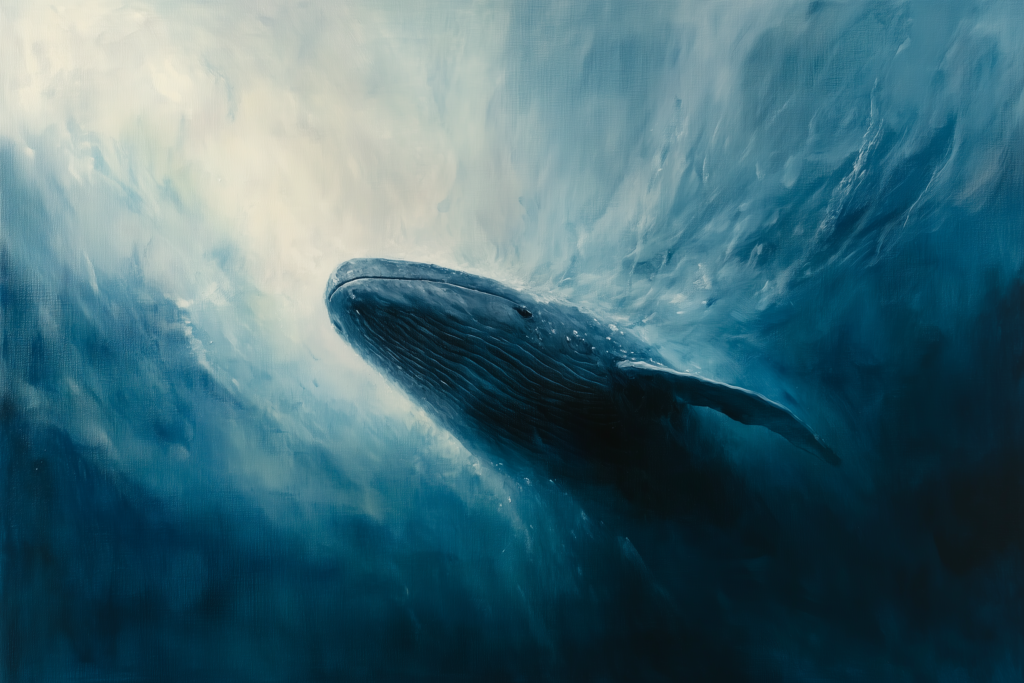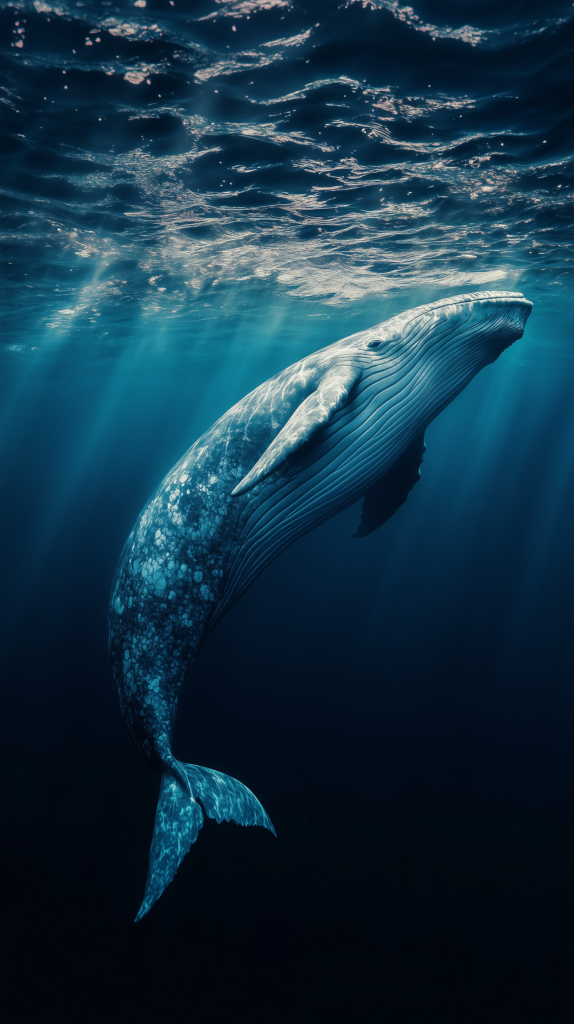Cetacean, “Blue Whale, Titan of the Endless Depths”
“Discover the jaw-dropping secret of the Blue Whale – the ocean’s colossal giant that defies imagination!”

The Blue Whale (Balaenoptera musculus) is the largest animal to have ever existed, reaching lengths of up to 100 feet and weighing as much as 200 tons. Its smooth, elongated body is a bluish-gray color, often appearing blue underwater, with lighter undersides and small dorsal fins near its tail. The Blue Whale’s immense size is complemented by a heart weighing as much as a small car, and it has baleen plates in its mouth that allow it to filter-feed on massive amounts of krill.
Behaviorally, Blue Whales are solitary or travel in loose groups, communicating over vast distances through low-frequency vocalizations that can be heard for miles underwater. Despite their size, they are gentle giants, moving gracefully through the ocean at a relatively slow pace. Their migrations span thousands of miles annually, moving between colder feeding grounds and warmer breeding areas.
Habitat-wise, Blue Whales are found in oceans worldwide, from the Arctic to the Antarctic, though they prefer deep, offshore waters rather than coastal regions. They tend to follow seasonal food sources, congregating in polar waters during feeding season and migrating to tropical and subtropical regions to breed.
The Blue Whale’s modus operandi is based on filter feeding: it uses its baleen plates to take in large quantities of water, then closes its mouth and pushes the water out, trapping krill, its primary food source. Each day, a Blue Whale may consume up to 4 tons of krill.
Their motivation is driven by the pursuit of sustenance and reproduction. They feed to fuel their long migrations and energy-intensive lifestyles and continue their species by mating and giving birth to calves, typically every two to three years. Despite their colossal size, Blue Whales are threatened by past hunting practices and environmental changes, making their conservation a priority for marine ecosystems worldwide.
Blue Whale 5e
Blue Whale Pathfinder
Blue Whale

Gargantuan Beast (Colossal), Unaligned
Armor Class: 15 (natural armor)
Hit Points: 435 (30d20 + 120)
Speed: 0 ft., swim 60 ft.
| STR | DEX | CON | INT | WIS | CHA |
|---|---|---|---|---|---|
| 34 (+12) | 14 (+2) | 30 (+10) | 6 (-2) | 20 (+5) | 16 (+3) |
Saving Throws: Str +18, Con +16, Wis +11
Skills: Perception +11
Damage Resistances: Bludgeoning, Piercing, Slashing (from nonmagical attacks)
Condition Immunities: Grappled, Paralyzed, Prone, Restrained
Senses: Blindsight 120 ft., Passive Perception 21
Languages: —
Challenge: 18 (20,000 XP)
Traits
Colossal Might.
The Blue Whale counts as Colossal, exceeding the usual Gargantuan size. Creatures and objects of Huge size or smaller automatically fail checks to resist being pushed, pulled, or shoved by the whale.
Ocean Sovereign.
The whale creates powerful currents with its movements. While in water, creatures within 30 feet of the whale have their swim speed halved unless they succeed on a DC 21 Strength saving throw at the start of their turn.
Aquatic Grace.
The whale does not provoke opportunity attacks while moving through water.
Whale Song.
The Blue Whale can emit low-frequency sounds that travel great distances. As an action, the whale can project a Whale Song audible up to 10 miles away. The song communicates general intent and can summon aquatic creatures (CR 1 or lower) within 1 mile to its location over the course of 1d6 rounds.
Actions
Multiattack.
The Blue Whale makes two attacks: one with its Tail Slam and one with its Baleen Maelstrom.
Tail Slam.
Melee Weapon Attack: +18 to hit, reach 20 ft., one target.
Hit: 45 (8d8 + 12) bludgeoning damage. Creatures of Large size or smaller must succeed on a DC 21 Strength saving throw or be pushed 30 feet away and knocked prone.
Baleen Maelstrom.
Melee Weapon Attack: +18 to hit, reach 25 ft., all creatures in a 25-foot cone.
Hit: 40 (8d6 + 12) bludgeoning damage. Creatures in the cone must make a DC 21 Strength saving throw. On a failure, they are pulled 15 feet closer to the whale and restrained (escape DC 21).
Lunging Dive. (Recharge 5–6)
The whale surges forward, displacing water in a massive wave. Each creature in a 50-foot cone must succeed on a DC 21 Strength saving throw or take 55 (10d10) bludgeoning damage and be knocked prone. The water in this area becomes turbulent, turning into difficult terrain for 1 round.
Legendary Actions
The Blue Whale can take 3 legendary actions, choosing from the options below. Only one legendary action can be used at a time, and only at the end of another creature’s turn.
Detect.
The whale makes a Wisdom (Perception) check.
Baleen Surge (Costs 2 Actions).
The whale makes a Baleen Maelstrom attack. Additionally, water within 50 feet churns violently. Creatures in the area must make a DC 21 Strength saving throw or be knocked prone and take 20 (4d8) bludgeoning damage.
Tail Sweep (Costs 3 Actions).
The whale sweeps its tail in a 30-foot radius. All creatures in that area must make a DC 21 Dexterity saving throw or take 45 (8d8 + 12) bludgeoning damage and be pushed 20 feet away.
Regional Effects
The presence of a Blue Whale influences the surrounding ocean within a 1-mile radius:
- Resonant Depths: The whale’s song reverberates through the water, creating faint vibrations. Aquatic creatures are calmed and will not attack unless provoked.
- Churning Currents: Nonmagical water becomes difficult terrain for creatures that fail a DC 16 Strength saving throw when they start their turn within 30 feet of the whale.
- Whale’s Domain: Predatory aquatic creatures avoid the region unless charmed or magically compelled.
These effects dissipate immediately if the whale dies.
Blue Whale

[This content was created by Paizo Publishing LLC for the Pathfinder rules but is not from the Pathfinder RPG product line.]
This massive aquatic mammal has bluish-gray coloration, a wide fluke tail, and a wide mouth filled with layers of baleen.
The imposing blue whale is one of the largest animals in the sea, though it is generally docile toward anything it doesn’t perceive as a threat. A filter-feeder, the blue whale does not look at humans or ships as potential meals, instead preferring to eat millions of tiny invertebrates known as krill, which it sucks through its baleen in massive gulps. The most dangerous thing about a blue whale, other than its sheer size, is its powerful tail, which can capsize boats and kill humanoids. These enormous mammals can be found in all of Earth’s oceans and seas. An adult blue whale is 100 feet long and weighs 200 tons.
Among the largest animals, cetaceans are as varied as the seas in which they make their homes. From the deadly white whale to the often-friendly dolphin, these air breathing aquatic mammals are perfectly adapted to life on the open ocean, and aside from their need to occasionally surface to breathe air, they are as versatile swimmers as the fish upon which they feed.
Cetaceans are split into two categories: toothed whales and baleen whales. Toothed whales eat fish, scooping up whole schools in their wide mouths, while baleen whales filter their tiny-sized food through a comb-like structure. Only toothed whales use echolocation; they possess a lumpy organ on the front of their head called a melon that aids in this ability.
Whalers often hunt cetaceans for their blubber, which whalers render down into oil. Whalers also prize cetaceans’ bones and teeth, which artisans use to craft weapons and art objects using a method of carving called scrimshaw.
Despite their massive size, cetaceans can be relatively docile, but predatory species or threatened members of any species make formidable foes in combat, as their size, speed, and relative intelligence make them more of a challenge than most mundane sea creatures.
| Blue Whale CR 12 |
| XP 19,200 N Colossal animal Init -1; Senses Low-Light Vision; Perception +27 |
| DEFENSE |
| AC 26, touch 1, flat-footed 26 (-1 Dexterity, +25 natural, -8 size) hp 184 (16d8+112) Fort +17, Ref +9, Will +8 |
| OFFENSE |
| Speed Swim 40 ft. Melee tail slap +21 (8d6+24 plus stun) Space 30 ft.; Reach 30 ft. Special Attacks capsize, swallow whole (4d6+16 damage, AC 22, 18 hp) |
| STATISTICS |
| Strength 42, Dexterity 8, Constitution 25, Intelligence 2, Wisdom 13, Charisma 6 Base Atk +12; CMB +36; CMD 45 (can’t be tripped) Feats Awesome Blow, Diehard, Endurance, Improved Bull Rush, Iron Will, Power Attack, Skill Focus (Perception), Weapon Focus (tail slap) Skills Perception +27, Swim +35; Racial Modifiers +12 Perception SQ hold breath |
| SPECIAL ABILITIES |
| Hold Breath (Ex) A blue whale can hold its breath a number of rounds equal to 10 times its Constitution score before it risks drowning. Powerful Tail (Ex) A blue whale’s massive tail deals more damage than a normal tail slap. The blue whale’s tail slap is a primary attack and applies 1-1/2 times its Strength bonus to its tail slap damage. Stun (Ex) A blue whale’s fluke can deliver a powerful stunning blow. A creature struck by this attack must succeed at a DC 34 Fortitude save or be dazed for 1 round. If the strike is a critical hit and the target fails its save, it is instead stunned for 1d4 rounds. The save DC is Strength-based. |
| ECOLOGY |
| Environment any ocean Organization solitary, pair, or pod (3-18) Treasure none |
Section 15: Copyright Notice
Pathfinder Adventure Path #59: The Price of Infamy © 2012, Paizo Publishing, LLC; Author: Tim Hitchcock.

 Buy me a coffee
Buy me a coffee